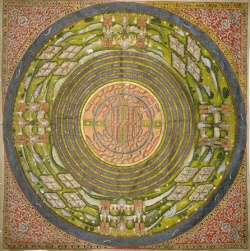Three schools of the south and seven schools of the north
three schools of the south and seven schools of the north]]
南三北七 (Jpn nansan-hokushichi )
Also, three schools of southern China and seven schools of northern China. Though generally referred to as "schools," they are actually the ten principal systems of classification of the Buddhist sutras set forth by various Buddhist teachers in China, during the Northern and Southern Dynasties period (439-589). Hence there are no specific names for the respective schools. T'ient'ai (538-597) employed this generic designation and outlined these systems in his Profound Meaning of the Lotus Sutra.
All three southern schools classified the Buddhist sutras into three categories—the sudden teaching, the gradual teaching, and the indeterminate teaching. The sudden teaching as defined by these schools corresponds to the Flower Garland Sutra; the gradual teaching, to the Agama sutras, Correct and Equal sutras, Wisdom sutras, Lotus Sutra, and Nirvana Sutra; and the [[indeterminate teaching, to the Shrimala and Golden Light sutras. The difference among the three southern schools lies in their arrangement of the sutras included in the gradual teaching. One school subdivides the gradual teaching into three divisions: the teaching of the reality of things (Agama sutras), the teaching of the nonsubstantiality of things (Correct and Equal sutras, Wisdom sutras, and Lotus Sutra), and the teaching of the eternity of the Buddha nature (Nirvana Sutra). Another of the three schools places the Lotus Sutra in an additional category by itself called the teaching uniting all teachings in the one vehicle, thus making four divisions within the gradual teaching. A third school adds a fifth division to the gradual teaching, establishing a separate category for the Vimalakirti Sutra, the Brahma Excellent Thought Sutra, and other sutras. This is called the division of the teaching extolling the bodhisattva practice.
The classifications by the seven northern schools are as follows:
(1) A division of the Buddhist sutras into five categories called the teaching of human and heavenly beings (ethical teachings), the teaching of the reality of things, the teaching of the nonsubstantiality of things, the teaching uniting all teachings in the one vehicle, and the teaching of the eternity of the Buddha nature.
(2) A twofold classification established by Bodhiruchi dividing Buddhism into the incomplete word teaching (Hinayana or Agama sutras) and the complete word teaching (Mahayana).
(3) A classification established by Hui-kuang, arranging the Buddhist teachings into four doctrines: causes and conditions (the doctrine of abhidharma works), temporary name (the doctrine of The Treatise on the Establishment of Truth ), denial of the reality of things (the doctrine of the Great Perfection of Wisdom Sutra and of the three treatises—The Treatise on the Middle Way, The Treatise on the Twelve Gates, and The One-Hundred-Verse Treatise ), and the eternity of the Buddha nature (the doctrine of the Nirvana Sutra and the Flower Garland Sutra).
(4) A five-division system, identical to Hui-kuang's, except that the Flower Garland Sutra occupies an additional category of its own called the doctrine of the phenomenal world.
(5) A classification into six doctrines, which adds to Hui-kuang's four-division system the two categories of the true teaching (Lotus Sutra) and the perfect teaching (Great Collection Sutra).
(6) A division of Mahayana into two types: one that holds phenomena to be real, and the other that views them as non-substantial.
(7) The one voice teaching, which maintains that the Buddha expounds only the one Buddha vehicle and there is no other teaching but this one Buddha vehicle that represents all his lifetime teachings.
T'ient'ai refuted these systems of classification and, refining and integrating all existing systems, formulated the classification of the "five periods and eight teachings" to assert the superiority of the Lotus Sutra over all other sutras.
See also; five periods and eight teachings.


